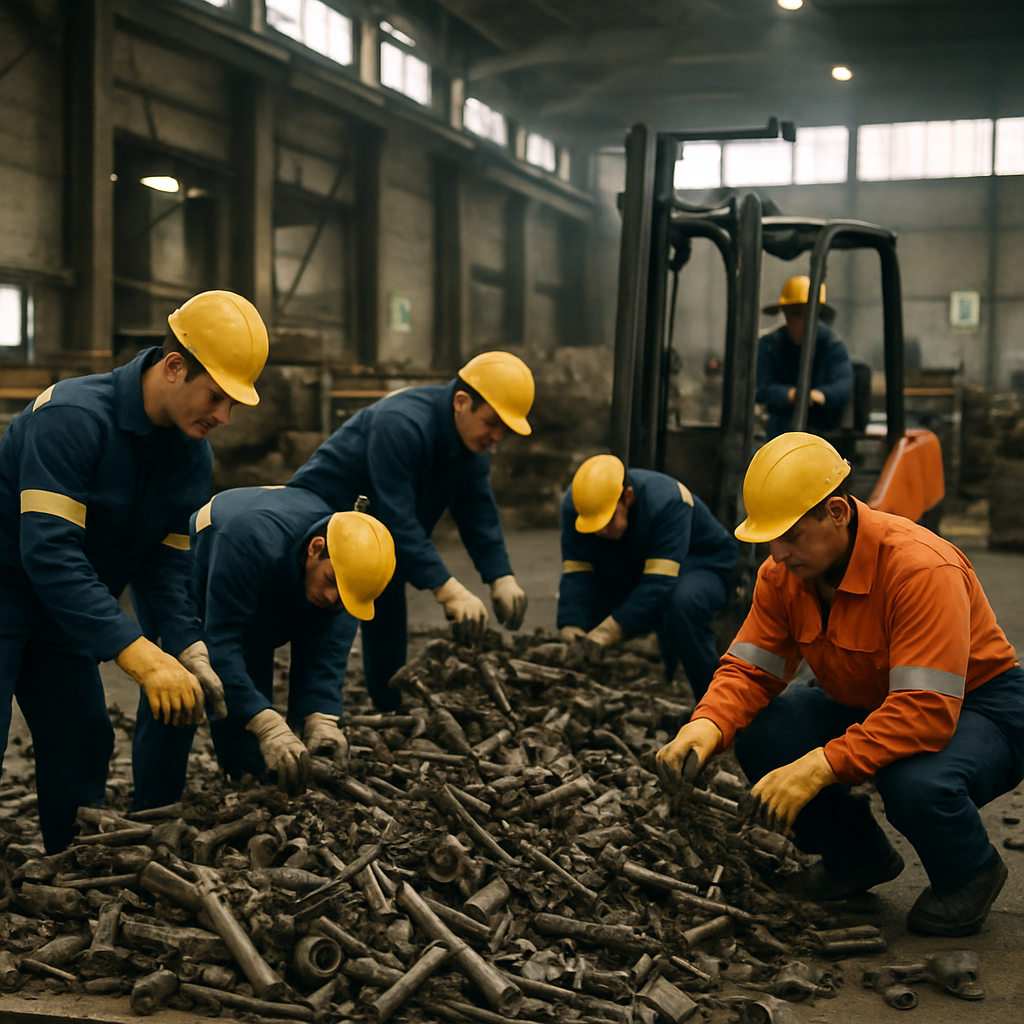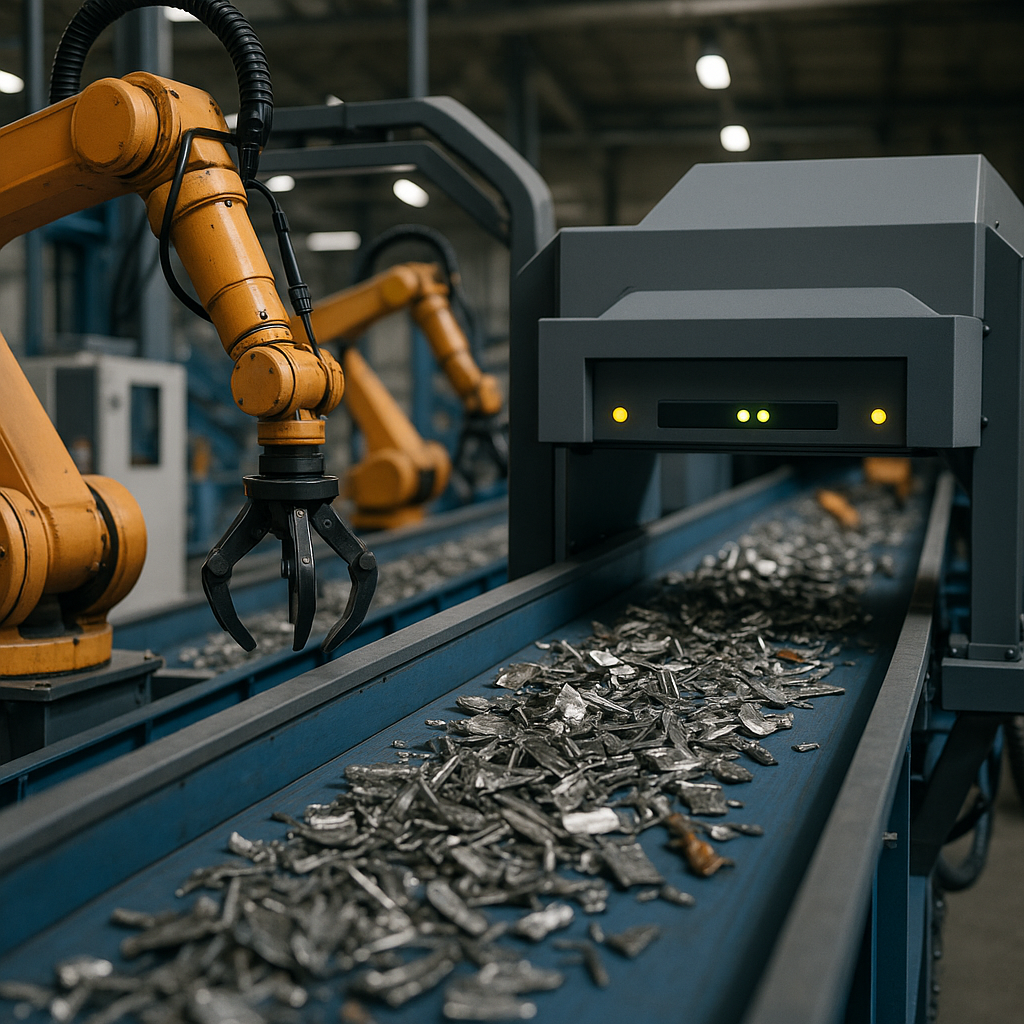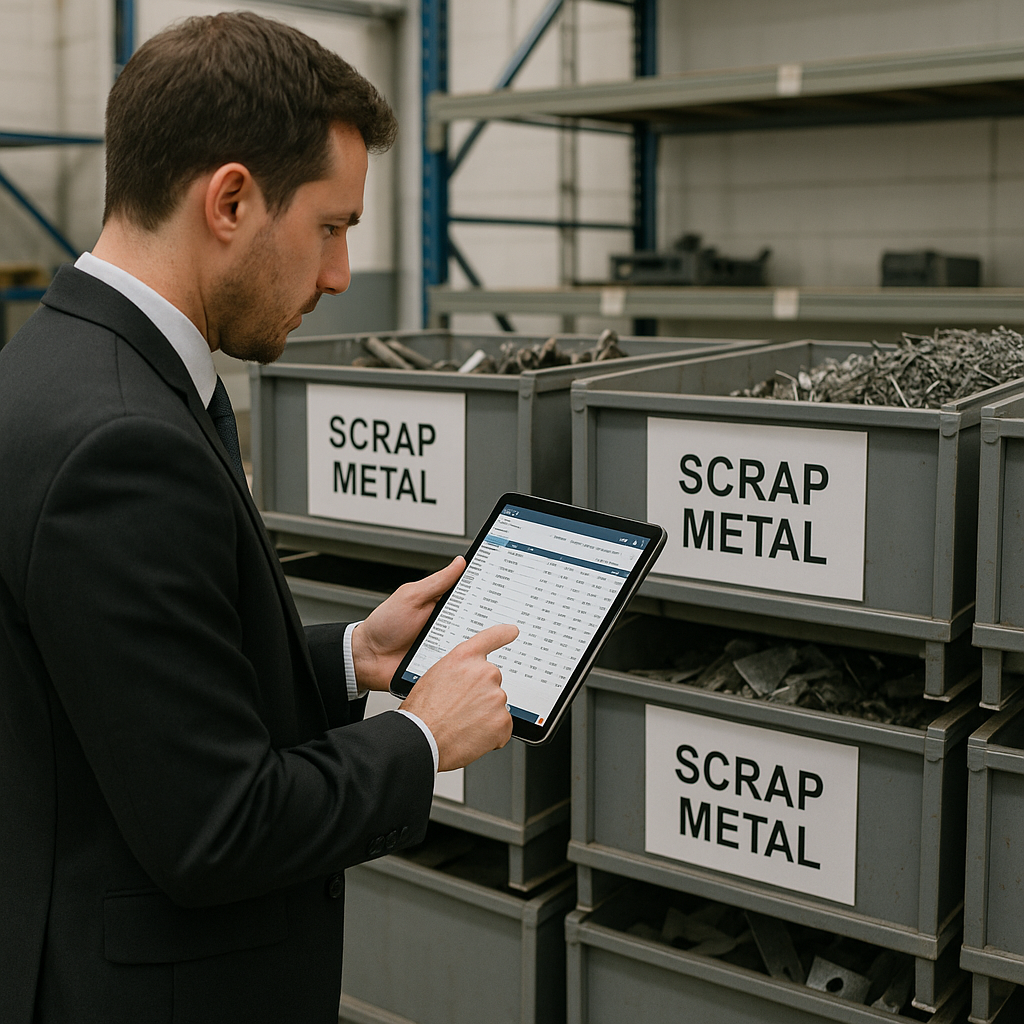5901 Botham Jean Blvd, Dallas, TX 75215
Discover the Importance of Optimizing Scrap Metal Recycling
August 14, 2025In today’s sustainability-focused economy, scrap metal recycling is a cornerstone of responsible waste management. The industry diverts millions of tons of valuable materials from landfills annually. Recycling metals uses significantly less energy than extracting virgin materials—up to 95% less for aluminum and 74% less for steel.
Despite its clear environmental benefits, the scrap metal recycling industry faces considerable challenges. Processors deal with sorting inefficiencies, contamination issues, and complex regulatory requirements. These obstacles often prevent businesses from maximizing both their environmental impact and operational profitability.
For companies engaged in metal recycling, optimization isn’t just about environmental stewardship—it’s about survival in a competitive marketplace. Balancing compliance, efficiency, and profitability requires strategic approaches to collection, processing, and material management. This article explores practical strategies to enhance scrap metal recycling operations through improved sorting techniques, regulatory compliance, and waste reduction methods.
How Can Businesses Implement Effective Scrap Metal Management?

Effective scrap metal management transforms waste into value while enhancing operational efficiency. For businesses generating metal waste, structured approaches ensure both environmental benefits and potential revenue. The key is to create systems that integrate seamlessly into existing operations.
Develop Strategic Segregation Systems
Successful scrap metal recovery begins with proper segregation at the source. Mixing different metal types significantly reduces their recycling value and complicates processing. Start by mapping all scrap generation points throughout your facility.
The most effective segregation approach includes placing dedicated collection bins at strategic locations where metal waste is generated. Use clearly marked containers for different metals like aluminum, steel, and copper. This step prevents contamination and preserves material value.
Color-coded bins and visual guides help employees quickly identify the correct disposal location. For manufacturing operations, placing these containers directly at production lines minimizes handling time and improves compliance with sorting protocols.
Establish Efficient Collection Processes
Once segregation systems are in place, establish regular collection schedules that align with your production volume. For high-volume operations, weekly service typically balances accumulation and space utilization. Construction projects may require flexible scheduling based on project phases.
Consider container options that match your specific needs. Roll-off containers work well for heavy materials and high volumes, while wheeled bins offer mobility for multiple collection points. Some businesses benefit from specialized containers with secure lids for high-value metals like copper or brass.
Partnering with a reputable recycling service ensures timely pickups and proper documentation. These providers can often supply appropriate containers and adapt collection frequency as your needs change.
Implement Regular Scrap Metal Audits
Conducting periodic audits of your scrap metal generation provides valuable insights for process improvement. These assessments help identify opportunities to reduce waste and optimize recovery. Start with a baseline audit that documents:
- Types and quantities of metal scrap generated at each location
- Current disposal methods and their effectiveness
- Potential recovery value of materials currently being discarded
- Bottlenecks or inefficiencies in existing collection systems
Use audit findings to refine your processes and track improvements over time. Many businesses discover significant value in materials they previously considered waste. Regular monitoring also helps identify unusual patterns indicating process problems or material theft.
Develop Comprehensive Employee Training
Staff engagement dramatically impacts the success of any scrap management program. Even the best-designed system fails without proper training and buy-in from employees handling materials daily. Effective training programs cover both practical aspects of scrap handling and the underlying reasons for proper management.
Include clear instructions on identifying different metal types, proper handling techniques, and contamination prevention. Explain how proper segregation impacts both recycling value and environmental benefits. Sharing program performance metrics with staff increases participation and compliance.
Consider implementing incentive programs that recognize departments or individuals who improve scrap recovery. When employees understand both the process and its value, participation rates typically increase by 30-40%.
Leverage Technology for Tracking and Reporting
Modern scrap management benefits from technological tools that enhance tracking and reporting capabilities. These solutions provide valuable data on recycling performance and help with regulatory compliance documentation.
Digital tracking systems can monitor material volumes, recycling rates, and program value. This information supports better decision-making and helps identify improvement opportunities. Advanced systems can generate reports for sustainability initiatives and regulatory requirements.
For businesses subject to environmental regulations, documentation capabilities prove particularly valuable. Proper tracking ensures you can demonstrate compliance with waste handling requirements and support sustainability reporting.
Continuously Improve and Optimize
Effective scrap metal management requires ongoing evaluation and refinement. Regularly review your program’s performance against established metrics and industry benchmarks. Look for opportunities to increase recovery rates, improve material quality, and streamline processes.
Stay informed about market conditions for recycled metals, as prices fluctuate based on supply and demand. Work with your recycling partner to optimize timing for material sales when possible. Building a relationship with an experienced recycler provides valuable market intelligence and processing expertise.
By implementing these structured approaches to scrap metal management, businesses can turn what was once considered a waste disposal challenge into a strategic advantage. Proper segregation, efficient collection, regular audits, employee training, and continuous improvement create a sustainable system that delivers both environmental and economic benefits.
What Technologies Can Enhance Scrap Metal Recycling Efficiency?

The scrap metal recycling industry is experiencing significant technological advancements that are transforming operations from collection to processing. These innovations are substantially improving efficiency, accuracy, and sustainability throughout the recycling lifecycle.
AI-Powered Sorting Systems
Artificial intelligence represents a major advancement in scrap metal recycling. Modern AI systems use computer vision, sensors, and deep learning to identify and separate different types of metals with remarkable precision.
Companies like AMP Robotics have developed systems capable of sorting materials at speeds of up to 120 picks per minute with 99% accuracy. These robots can distinguish between similar metals like aluminum foil and aluminum cans or brass and stainless-steel silverware. Facilities using these systems report up to 60% improvements in labor efficiency and 11% increases in recyclables capture.
AI sorting systems excel at detecting contaminants such as glass, plastic, wood, and other non-metallic materials that would otherwise lower the quality and value of recycled metal, leading to purer materials with higher market prices.
RFID Tracking Technology
Radio-frequency identification (RFID) tagging has transformed how recycling facilities track materials throughout the recycling process. RFID systems provide real-time monitoring of scrap metal from collection to processing, improving inventory management and reducing material losses.
These smart tracking systems allow facilities to monitor fill levels in collection containers, optimize pickup schedules, and verify material origins. This technology helps prevent theft and ensures compliance with regulations while providing valuable data for process optimization.
Smart bins equipped with RFID sensors can detect when full, facilitating more efficient collection routes and reducing unnecessary transportation costs and emissions.
Advanced Sorting Technologies
In addition to AI, other innovative sorting technologies are enhancing metal recovery rates and purity. X-ray fluorescence (XRF) analyzers can identify various alloy grades and analyze their chemical composition at material transfer points, ensuring quality control throughout the process.
Eddy current separation uses powerful magnets to create currents in non-ferrous metals, separating valuable materials like aluminum and copper from mixed waste streams. This technology processes large volumes quickly, enhancing overall productivity.
Laser-Induced Breakdown Spectroscopy (LIBS) enables real-time analysis of metal composition by directing laser pulses at material surfaces and analyzing the emitted light for rapid, accurate metal identification.
Blockchain for Supply Chain Transparency
Blockchain technology creates secure, transparent digital ledgers that track scrap metal from collection through processing and sale, ensuring fair payments and preventing fraud within the recycling ecosystem.
The technology verifies the authenticity of recycled metals by storing information about origin, composition, and quality control data. While industry-wide adoption is still developing, blockchain promises improved traceability and trust throughout the recycling supply chain.
Mobile Processing Units
Mobile scrap processing units bring recycling capabilities directly to collection sites, reducing transportation costs and delays. These portable systems are especially valuable for remote areas where transporting scrap to central facilities is impractical.
By processing materials on-site, these units reduce the carbon footprint associated with transportation while enhancing operational efficiency. Construction sites benefit greatly from this technology, as they can immediately process and repurpose scrap materials.
Hydrometallurgical and Electrochemical Recovery
Advanced chemical processes are invaluable for recovering precious and rare metals from complex waste streams. Hydrometallurgical processing uses aqueous chemistry to leach metals from shredded materials, while electrochemical recovery employs electric currents to precipitate metals onto electrodes.
These techniques are particularly effective for recovering valuable metals from electronic waste and industrial residues. They’re more environmentally friendly than high-temperature smelting and can achieve high purity levels in recovered metals.
The adoption of these innovative technologies in scrap metal recycling offers significant economic and environmental benefits. By improving efficiency and accuracy, these systems reduce operational costs while increasing the value of recycled metals. Enhanced sorting capabilities lead to higher recovery rates, maximizing the amount of metal reclaimed from scrap and reducing reliance on virgin materials.
As these technologies continue to evolve, the scrap metal recycling industry is poised to make even greater contributions to resource conservation and environmental sustainability.
How Can Businesses Optimize Their Scrap Metal Inventory Management?

Inventory management is a cornerstone of successful scrap metal recycling operations. Companies that adopt robust inventory tracking and management systems gain vital visibility into their materials, enabling better decision-making and profitability.
Businesses handling large volumes of scrap metal face unique inventory challenges, including fluctuating market prices, varying material quality, and complex logistics. Addressing these challenges requires specialized strategies tailored to the recycling industry.
Automate Tracking Systems
Automation reduces manual errors and increases visibility and control throughout the recycling process. Effective automated inventory systems should include:
- Real-time inventory tracking across multiple locations
- Digital identification tools like barcodes and RFID tags
- Mobile applications for staff to inspect, grade, count, and reclassify materials
- Integration with inbound and outbound scales to minimize data entry errors
- Authorization controls for inventory adjustments
Automation tools help recyclers monitor inventory in real-time, ensuring materials are easily located for processing or sale. This leads to faster inventory turnover and streamlined operations.
Use Analytics for Inventory Insights
Data analytics provide valuable insights into inventory positions and valuations. By implementing analytics tools, businesses can:
- Understand cost build-up and margin rates amid price fluctuations
- Analyze seasonal trends and their impact on inventory levels
- Make data-driven decisions about buying or selling to optimize inventory
- Identify the most profitable suppliers and customers
Advanced analytics enables recyclers to track and report on recycling rates, emissions reductions, and resource utilization. These insights are essential for purchase, sales, and operations teams seeking process optimization.
Integrate Management Practices Across the Recycling Chain
Effective inventory management must be integrated into all aspects of operations. This includes:
For purchasing teams, accurate inventory records reveal what has been purchased, from whom, at what price, and where it’s located. Production teams benefit from understanding material availability to plan processing. Sales teams can use inventory data to identify available finished goods, accelerating turnover and streamlining shipments.
Embedding inventory best practices across these functions creates a cohesive system that enhances efficiency at every stage of the recycling chain.
Conduct Regular Cycle Counts
Regular cycle counts ensure inventory counts remain accurate and up-to-date. These counts help:
- Verify that physical inventory matches system records
- Identify discrepancies before they become significant issues
- Pinpoint areas for improvement in inventory management
- Maintain compliance with regulations
Digital mobile applications designed for cycle counting can streamline this process, making it less labor-intensive and more accurate.
Understanding all dimensions of inventory, from material classification to location tracking, provides recyclers with complete visibility and control over their business processes. Achieving this requires a fully integrated inventory management system as part of a comprehensive enterprise solution.
By implementing these best practices, scrap metal recyclers can optimize inventory management, reduce costs from excess inventory, improve cash flow, and ultimately increase profitability.
Conclusion: Embracing Optimization for Sustainable Scrap Metal Recycling

Optimizing scrap metal recycling processes is a significant opportunity for businesses to meet both economic and environmental goals. In this article, we’ve explored how strategic management, technological integration, and inventory control can transform scrap operations from cost centers into value-generating assets. Implementing sorting systems, market monitoring, and performance tracking establishes a framework for sustainable recycling that minimizes waste and maximizes returns.
When businesses focus on optimizing their scrap metal recycling, they contribute to resource conservation, energy savings, and reduced carbon emissions while enhancing their bottom line. These dual benefits make scrap metal optimization not just an environmental choice, but a smart business decision in today’s resource-conscious marketplace. For your recycling needs, contact Okon Recycling at 214-717-4083.
